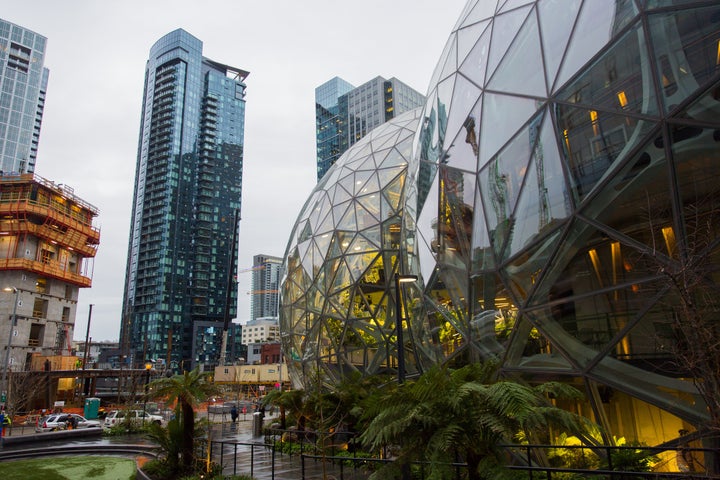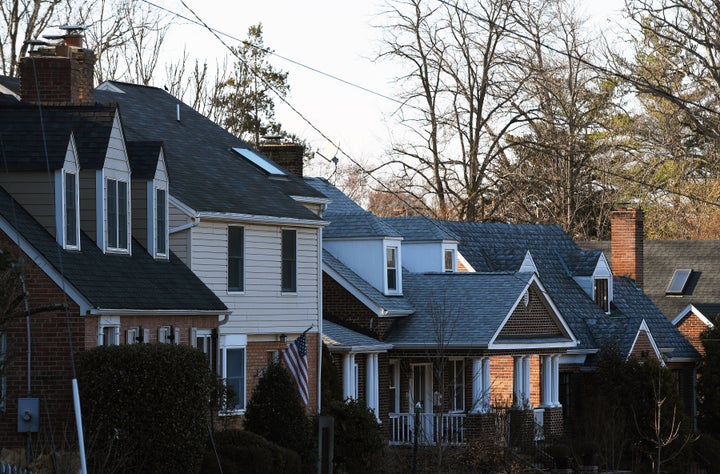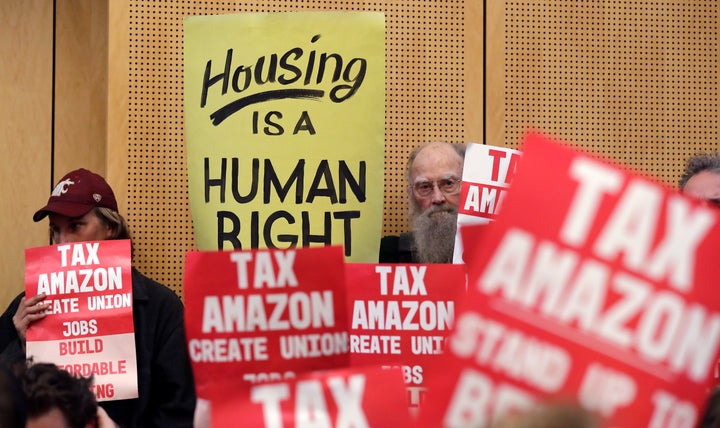Like most Seattleites, I have a complicated relationship with Amazon.
In the “pro” column, the company has been the driving force behind our city’s recent renaissance. In the eight years since Amazon started adding tens of thousands of jobs, Seattle has achieved the country’s second-highest per-capita income and its 11th-fastest job growth. We host a disproportionate share of America’s best restaurants. The influx of tech workers and tax revenues have led a surge in public spending. Our buses run more often than ever, our light rail system is expanding and our parks are so well manicured that we sometimes forget we can only enjoy them three months out of the year.
In the “con” column, however, is the undeniable fact that the city’s boom has come on the backs of its poorest residents. The influx of population — Seattle grew more in the last seven years than it did during the previous 30 — has pushed housing prices upward, turning homeowners into millionaires and renters into refugees. Our homelessness crisis is so bad the mayor has declared it an emergency. Our public schools are running the largest deficits since the 1970s. All those fancy new restaurants? Like a lot of other Old Seattle townies, I can’t afford a meal at most of them.
But the most important thing to know about what has happened to Seattle is that it’s not all Amazon’s fault. Every effect of the company’s expansion was both predictable and preventable.
This week, Amazon announced that its second headquarters, known as HQ2, would be split between New York City’s Queens borough and “National Landing,” a made-up name for an existing Virginia suburb of Washington, D.C. The company will reportedly inject at least 25,000 new jobs and billions in investment into each site.
It’s going to be disruptive, but it doesn’t have to be disastrous. Amazon is a giant, amoral, profit-driven behemoth. There’s nothing its new hosts can do about that. What they can do, however, is pass laws that ensure the company’s effects will be positive.
There is no such thing as a good or a bad corporation; there are only good and bad laws regulating them. Here are some of the things Seattle did when we became a company town and others that some of us wish we would have done sooner.

Make Work Equitable
The logic behind New York’s and Virginia’s massive subsidies for Amazon ($48,000 and $22,000 per job, respectively) is that the company will have a multiplier effect, forming clusters of tech and service workers around its campuses.
There’s even evidence this will happen the way legislators want it to. A 2017 study of more than 300 cities found that each new high-tech job created five more in supporting industries. The study also found, however, that the majority of these additional jobs weren’t in high-tech sectors. Each highly paid, highly technical position created three jobs in “non-professional” occupations. What this means for the HQ2 cities is that, along with five more digits of software developers, they could find themselves with up to 75,000 new waiters, chefs, hairdressers, cashiers and janitors.
Virginia’s minimum wage is $7.25 an hour. Neither the state nor the city of Arlington, where the bulk of Amazon’s investment will go, have policies guaranteeing paid sick leave or family leave for workers. If National Landing doesn’t improve basic working conditions, the primary effect of Amazon’s investment will be the creation of an army of impoverished, insecure workers. If Amazon, a massive, publicly traded corporation, can guarantee its workers a $15 per hour minimum wage, Virginia has no excuse not to match it.
Legally speaking, things look slightly better in New York. The city already has paid sick leave and family leave and a minimum wage heading toward $15 an hour. Where the city falls down, however, is enforcement. A 2017 evaluation found rampant evidence of informal work, wage theft and sexual harassment, especially among female workers and immigrants. Nearly 20 percent of food-service employees hired as “contingent workers” said they were paid below the minimum wage.
Many of the workers Amazon is hiring for its HQ2 locations will enjoy six-figure salaries alongside luxurious benefit packages. If its new host cities want to make the most of the company’s investment, the least they can do is crack down on the exploitation of the people feeding, clothing and cleaning the homes of its workers.

Build Lots of Housing
One of the painful, forgotten truths of municipal politics is that cities do not decide how large their populations will be. Amazon did not ask Seattle’s permission to expand by 35,000 workers in 2010. The 114,000 people who moved here in the last eight years did not apply for visas. It all just … happened.
But, although cities don’t control their own growth, they do control how they respond to it. Since Amazon began its rapid expansion, Seattle has built about one new home for every three new jobs. That makes us superstars compared with San Francisco, where the ratio is 1 to 8, but it’s still nowhere enough to meet the need.
The result is nearly a decade of relentless but mostly invisible gentrification. While plenty of glass-and steel-towers have gone up downtown, the vast majority of the city is preserved in amber by zoning regulations that make it illegal to build anything other than McMansions. That hasn’t stopped tech workers from moving here, but it has pitted them against each other in bidding wars for the homes already here. According to their Zillow application, the two Microsoft employees who moved into my last apartment — I decided to move out after two years of 10 percent rent increases — have a combined income of $248,000 per year. The look of my neighborhood didn’t change, but the wealth of its residents did.
Amazon’s new host cities shouldn’t make the same mistake. Even before the company announced its new host cities, Arlington had a housing shortage, steeply rising prices and a local debate about whether to loosen restrictions on building apartments. Across the river, Washington’s lack of affordability is well-documented, and the city is already behind on the estimated 690,000 units of housing it needs by 2045 just to keep up with job growth.
Queens, as part of a city slightly more comfortable with skyscrapers, looks better on this score. The HQ2 site in Long Island City has already built more housing than any other New York neighborhood since 2010. Still, since Amazon’s announcements, calls to halt construction and slow down a planned rezoning are intensifying.
Local residents’ worries make sense. The neighborhood is already suffering from rapid gentrification, and Amazon’s buildings are sited right next to the country’s largest public housing complex. The mayor’s and governor’s ostensible reasons for inviting Amazon are to lift up local residents, not to displace them with luxury condos.
But if Seattle’s experience demonstrates anything, it is that refusing to build new housing won’t lessen gentrification pressures. It will intensify them. Amazon workers, like everyone else, want to live close to their jobs. If the city builds as tall and as dense as possible, new apartments could act as a release valve for the influx of new demand. If the city refuses to ― like San Francisco has for decades ― rich techies will simply buy or rent up all the real estate that’s already there.
No one likes a bunch of soulless new apartment towers going up next door. But in the last two years, as Seattle has added them by the dozen, rents have finally leveled off. We’ve also added fees on developers that pay into a fund to preserve affordable housing. There is still a long way to go, but the city is an object lesson in the principle that you can build your way out of a housing crisis ― even if what you build isn’t always pretty.

Don’t Forget the Fundamentals
King County, where Seattle sits, has the third-largest homeless population in the United States. Nearly 50 percent are unsheltered.
Last year, city officials passed a modest tax on large corporations to scale up the city’s response to the crisis. Almost immediately, Amazon officials threatened to halt the company’s expansion and move thousands of jobs to other cities. Then, when the City Council didn’t relent, the company teamed up with Starbucks to fund an effort to repeal the tax through a ballot initiative.
It worked. Facing a deep-pocketed publicity campaign, the City Council reversed its decision and repealed the law. Somehow, two of the world’s largest corporations convinced voters that mandatory contributions to solving the problems they (partially) helped cause was a bridge too far. Two months later, Amazon CEO Jeff Bezos announced that he was donating $2 billion, or around 1.2 percent of his personal wealth, to ending homelessness and supporting early childhood education. He declined, however, to specify which charities he would give to or how much per year.
It is an obvious lesson, but one that city leaders must be constantly reminded of: Corporations are not your friends. Amazon has neither a moral conscience nor a mandate for social responsibility. It is simply a company that will, like all others, always put pleasing its shareholders above caring for its community.
City officials need to keep this fundamental fact at the front of their minds. Amazon’s press release this week highlighted the “community investments” it would make at each of its sites. In New York, it will reserve office space for an elementary school and artists’ workspaces. In Virginia, it will donate funds to improving pedestrian, airport and subway infrastructure.
But as Seattle’s experience over the past year demonstrates, these community investments are voluntary, contingent and minuscule compared with the effects the company will have. Any attempt by the city to squeeze more funding from the company ― or make its commitments mandatory and ongoing ― will invite massive backlash, including disinformation campaigns and cynical political posturing.
New York and Virginia already have progressive income taxes, which means they’re better-positioned than Seattle to turn Amazon’s investment into higher tax revenues. But in the future, as the company strains municipal infrastructure and political goodwill, city leaders will need automatic systems to force the company to chip in for mitigating its effects. And if politicians forget this obligation, their voters will have to remind them.
So, take it from Seattle, HQ2: Amazon won’t be good for you or bad for you. It will be both. And it’s still up to you to decide the balance.

